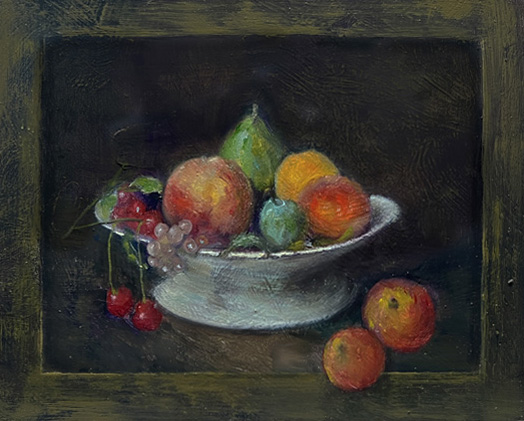I’m going to explain what I’ve been doing. It’s been fun. I can’t use solvents in my studio and the use of solvent in oil painting is part of the traditional painting process. It’s used for brush cleaning, to create a thin wash to work out the values of the painting or to paint the first layer with a thin wash of color and to thin oil paint throughout to one’s desired consistency. Mixed with oil paint, the paint dries faster. Sometimes a solid layer of the mid color of the painting is applied overall to the surface and shapes are wiped out to create initial shapes in the painting.
for these reasons, I feel a little handicapped in not being able to use solvent. Many people can’t use it. There can be an allergic reaction which causes head aches, nausea or whatever. The adverse reaction can develop over time. Some of these products are odorless – which I think is a terrible thing. You can’t even tell if solvent is building up in the studio. Without going too far into this. I heard someone mention an alternative. The suggestion came from a very experienced oil painter who post lots of technical info on YouTube. He said †hat for quite a while now, he has used a watercolor wash as a background or first painting layer. Originally he used Acrylic. It “dries” quickly, but the fact is it should cure for 1 to 2 days before painting on it in oil, so he changed to watercolor. So, I decided to try watercolor A normal person would likely have tested this process using watercolor from a set they may have at home, or might purchase inexpensively on Amazon. Not being a normal person, I decided I would make a set of watercolor colors – specific to what I might use for subdued background colors. I probably looked at 30 YouTube videos to learn how to make a watercolor binder. The process is more complicated and requires more ingredients than in making oil paint which I’ve made for years. The other thing is that after grinding the watercolor it has to dry which can take 2 to 3 days curing before using the product. I guess you don’t have. to let it dry but its harder to control the amount on the brush if it’s wet. I initially thought I would make 3 colors. however, I made 12. I couldn’t help it. I had the pigments already and in fact, I had all the ingredients I needed – gum Arabic, glycerin, honey, and clove oil. There are many recipes which can affect the functionality and artistry of watercolor. It’s been fun to learn about which is why I couldn’t get a painting done last week. I spent days studying, and days making the watercolor. I could have gone a much simpler route but I really enjoy making stuff. For my purpose they’re fine. Whether or not they’re really any good – I have no ideabut they will work for me.
Then I selected a painting to test my new watercolor as a background and an initial wash.The painting was interesting to copy. It’s not really a copy but I certainly copied many of the elements from the painters work. I like the fact that I used bristle brushes only. I don’t think I’ve ever done that before. In addition to creating texture which I love, it keeps all the edges soft. I’ll have to try that with a portrait. Actually, I did use a small sable for those delicate little champagne grapes. I then added a border and allowed a couple pieces of fruit to roll out the frame – something I like to do – most often with grapes.
Professional WC is most often in very small containers. My watercolors are large allowing me to insert a large brush into the containers for large strokes rather than small sable brushes most often used in WC painting. Notice my name is not on the painting. I don’t think the artist would like his name on it either. Well, that’s my story. Have a great weekend. Winifred

